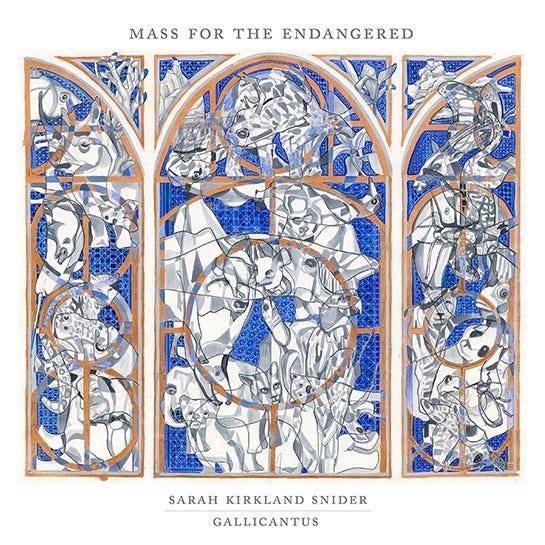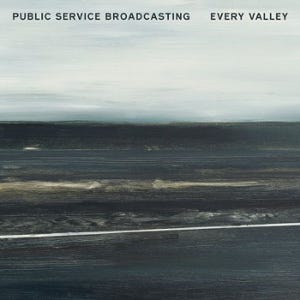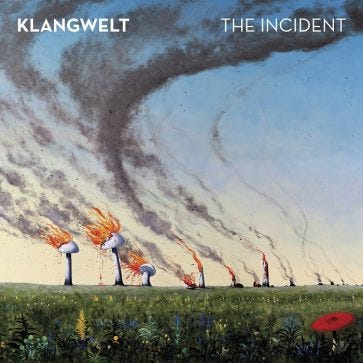I grew up in the 70s in a small Canadian prairie town during the era of progressive rock bands like King Crimson and Yes. They’re what I listened to on vinyl. If you were driving or hanging out at the mall, you’d be hearing top-40 tunes almost exclusively. But Brandon, Manitoba is a university town with a music school, so I also grew up around summer madrigals where they played the hits of the 1600s, and my parents listened to old-timie music as well as Tschaikovsky and Beethoven.
Fast forward to 2023, and the grocery stores are still playing the same top-40 hits as they were in the 80s. I know a lot of people my age who are cool with that; they listen backward, to the music of their youth, but I like to keep current, and there is a vast torrent of great music flooding the world right now. I feel a bit like the Angel of History, being blown backward into the future while I snatch at composers and bands as they fly by. I’ve only just discovered Hania Rani or Agnes Obel when there’s a new Fleet Foxes album or I stumble across a composer like Anna Clyne or Dobrinka Tabakova. There isn’t enough time in the day to take it all in.
Lately, though, some pieces are holding my attention not because they capture the aesthetic of the day, but because they engage with the moment in other ways: they are music about life in the Anthropocene. Here are a few that I’ve had on steady rotation.
The Lost Birds: An Extinction Elegy
Christopher Tin is a musical chameleon; he’s done chamber music and video game soundtracks; in fact, his Swahili-flavoured hit ‘Baba Yetu’ became the first piece of video game music to win a Grammy Award. He has an impressive ability to mimic styles and modes from across the world. He’s such a good mimic that, up until recently it seemed to me that I’d never heard him in his music, only the year, place, or culture whose skin he was putting on.
That changed in September, 20222, with the release of his crowdfunded project, The Lost Birds. This is an album of choral music—and yes, choral music is alive and well in 2023. This piece at its best is absolutely gorgeous. My particular favourite of this song cycle is “Bird Raptures.”
The dark kernel of this project is its theme: The Lost Birds is about extinction. It’s a hymn of regret for the voices we no longer hear; for a world progressively falling silent all around us. Even as we’re humming along to Tin’s lovely melodies, the lyrics begin to worm their way into the unconscious, leaving us increasingly unsettled despite the beauty—because the well-turned words unfold by degrees a deep sorrow at humanity’s careless folly. As a listener, you’re uplifted by the lush and airy soundscapes and simultaneously descend into an abyss of moral outrage and guilt. And make no mistake: we need to feel these things, to be transported both by hope and by an implacable, unstoppable anger at our own mistakes. The alternative is that we passively let extinction silence the chorus of the world—adapting a poem by Sara Teasdale, the chorus reminds us that
Perhaps after all
The skies will not open for us
Nor heaven be there at our call,
After all that was never done.
Choral music may not be your thing, but Tin is able to say things that we need to hear but that can’t be conveyed in anything other than the language of music.
Mass for the Endangered
More austere and formal, Sarah Kirkland Snider’s Mass for the Endangered is no less powerful (here’s the official website). Yes, this is a mass, and an overt prayer for forgiveness; but it is the natural world we are begging to forgive us. Snider’s chorus inverts the traditional Catholic mass by using its structure not to lift our eyes from the world to the heavens, but to lower them from the heavens of our own distractions—our consumerism, doomscrolling, VR and TV—and bear witness to the world we are destroying.
While Christopher Tin has the genius of mimicry, Snider presents us with a unique voice. Mass for the Endangered is not like anything else out there; for that reason alone it deserves a listen. And while Tin’s poetic adaptations can elicit powerful emotions, ultimately he does not tell us what we should do with our anger or despair, other than, vaguely, to “hope.” Snider is more direct:
Lay down the spear, lay down the hook,
lay down the gun, the knife, the net.
No majesty in poison. No virtue in
the snare.
The centerpiece of this mass is the Credo, the statement of faith and commitment; musically, it’s transcendently beautiful. It too tells us to take a stand; but more than that, it articulates a position, a unifying set of values that are shared by whoever it is that would use this mass in their ceremonies:
We believe in all who are voiceless.
We believe in all who are at risk.
We believe in all who are helpless.
We believe in all who are at risk.
What’s different here is that these “all” are not human. The emotional core of anthropocenic music is not the same as the poisoned heart of the 20th century’s. Snider’s Mass is not like Penderecki’s Threnody to the Victims of Hiroshima or sir Peter Maxwell Davies’ Eight Songs for a Mad King. (I recommend both, but only if you have the emotional strength of an emergency paramedic.) This mass is not about the horror or despair of the human condition, or even about human evil in particular. It’s not that self-centered. It also seems distanced from the social, humanistic concerns of Greenpeace or The Whole Earth Catalog. We’re not just saving the whales here, to become heroes in some movement. The Mass is about taking the situation far more seriously; it’s about severing our sense of our own holiness, the smug exceptionalism of our assumed separation from the Earth. If our task is serious, then it transforms every facet of our lives, including who—or what—we identify with.
This mass demands that we lower our eyes from heaven, and get to work.
Every Valley
By contrast, Every Valley by Public Service Broadcasting is entirely and solely about people. While I think the posthumanism of the Mass for the Endangered is important, there’s also a story unfolding that we’re getting to know very well after two centuries of boom-and-bust industries, each one of which seemed like the final episode in human history at its peak, but proved just as mortal as the one before it. In this case, the hero is Welsh coal, the culture, and communities that grew up around it and were destroyed in the blink of an eye the moment it became uneconomical.
If you don’t know Public Service Broadcasting, they are a rock band, but one that’s fully integrated video and audio sampling, orchestral scoring, and “found” soundscapes into their performances. The genius is that their sampling is usually from public archival documentaries and broadcasts of the last century. If that sounds weird, it’s not, really: try “Spitfire” and “Go!” if you want to get a flavour of what they do. They know how to rock out, and they’re a lot of fun.
Every Valley presents us with the actual voices of the people who worked in Welsh coal, mostly in the Romney Valley. “We all thought we’d be there for the rest of our lives. But of course, it didn’t turn out like that,” says one of the miners that PSB quotes. Another talks about “the pits being the mother of the village,” and how the end of coal gutted communities that had come to be entirely organized around it.
If you’re worried that AI is coming for your job, then Every Valley can give you an ominous sense of what that emotional and political journey is going to feel like. The sense of disruption by new technologies that we feel today is not new, not by a long shot. In fact, it’s deeply baked into our cultural memory, and this album does a wonderful job of giving us access to those memories. In that sense, Every Valley does what the best strategic foresight does: it helps innoculate us against the inevitable surprises that the future will bring.
It’s also dynamic and energizing music, like auditory coffee. Give it a try.
Fordlandia
You’ve almost certainly heard Jóhann Jóhannsson’s music, and you’ve almost certainly liked it. He’s best known for his soundtracks, for films such as Arrival, Sicario, and The Theory of Everything. Most of his work was commissioned for film projects but sadly, he died in 2018 at the age of 48. This means that like Christopher Tin, most of his catalogue consists of work-for-hire, which doesn’t mean those pieces are any less important, but that they reflect the needs and aesthetic of specific clients, not necessarily his own. Fordlandia is different; it’s one of his few solo projects.
There was a real place called Fordlandia, and it was… bizarre. Henry Ford built it as a company town to produce rubber for automobile tires. As Wikipedia puts it,
Ford bought two and a half million acres for Fordlandia, costing him $125,000, and had many Brazilian workers and their families come to live in Fordlandia (most ended up complaining about it). Too much time and money were spent on recreating a beautiful, American town than working out how to successfully grow rubber in the Amazon.
Fordlandia was Henry Ford’s attempt to create a kind of Ayn Rand Utopia in the wilderness, and boy did it fail. Jóhannsson’s work traces the weird emotional arc of egomania, visionary aspiration, and unbridled power unleashed on ordinary people, from the haunting title piece to the beautiful despair of “How we left Fordlandia,” which ends with one of the longest fade-outs I’ve ever heard.
Fordlandia is a testament to the folly of the industrial age and how it put its stamp on the physical world in the form of artifacts like, well, imitation American towns built in the Brazilian rain forest. Places that are now abandoned, recovered by nature, literally post-apocalyptic at least from the standpoint of the would-be visionaries who built them.
Incidentally, Johannsson also did a piece about coal mining that traces almost exactly the same arc as Every Valley. It’s called The Miners’ Hymns. I haven’t yet listened to it, but it’s on my (ever-growing) list.
Pandemic Bonus: The Incident
I’m including Klangwelt’s The Incident mainly because it helped me get through the lockdown period of the pandemic. During that weird time when the ever-present hum of the distant freeways was silenced; when we crossed the road if we encountered other people on our brief walks outside; when we watched video of Italian apartment-dwellers serenading one another from their balconies while forbidden to go outside; as cases and deaths started to balloon in long-term care homes; when Toronto’s largest hospital built an annex of tents to accommodate new cases; when local streets were blocked off and converted to pedestrian traffic only, because no one was driving… During this time I listened to The Incident, and it all made a little more sense to me.
Precisely what the “incident” that this musical journey relates to is never specified, but as with the emotional arcs of Every Valley and Fordlandia, it evokes a narrative, writ as it were in Rorschach ink-blots. Each song is an enigma but leads logically along the same route we traveled during Lockdown—through uncertainty, anxiety, panic and unfocused anger, conflict, and chaos, all the while refusing to explain itself in any coherent way. The title song, “The Incident,” ends with a woman’s whispered words: “I never saw it coming.” The finale is hopeful, but it’s a hope that can only be realized through the healing power of time; it’s called “Decades.”
This is electronica, which may or may not be to your tastes. As I said, I grew up in the time of prog rock and art rock, and I listen to a lot of Delerium and Conjure One when I’m writing. So The Incident is right up my alley. I’m including it here more because I like it than because I think you might. It helped me make sense of a strange and dark time; and that, I think, is what the music of the Anthropocene is intended to do.
Uncertain Postscript
There are hints in these pieces that we are leaving behind the obsessions of the 20th century, and indeed modernism and postmodernism themselves (in visual art, the work of Kent Monkman hints at the same). I’m not sure enough that this is really happening to write about it as a movement or cultural transition… but we’ll see. The post-pandemic world may turn out to be as different as the post-WWI world was from the Belle Epoque just before it.
It’s likely that only distance will show us if this is the case. But I’m watching—and listening—for the signs.









